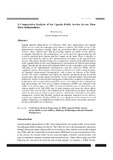A comparative analysis of the Uganda public service across time since Independence
Abstract
Uganda attained independence on 9th October, 1962. Since independence, the Uganda Public Service sector has undergone three phases of reforms. The Public Service is the administrative machinery through which the government effects and delivers public services. These reforms have had far-reaching impacts on public service delivery in Uganda. Nonetheless, the common focus on service delivery improvement has not critically analysed these reforms and their impact on the same. There is therefore a need to understand the reforms, their implementation and impact on the Uganda Public Service. This article therefore brings out a comparative analysis of the different phases of the Uganda Public Service since independence, and analyses the reforms and resultant impact. Specifically, the status of the Uganda Public Service is identified, while critically reflecting on the administrative bureaucracies and the respective Public Service regulatory regimes. This analysis is based upon a critical review of the existing literature on Uganda’s administrative bureaucracies, with a focus on reforms in the Public Service. The article establishes that before the reforms, specifically during the period of autocratic and corrupt regimes, the Public Service remained highly centralized and politicized. Further, it was characterised by poor remuneration, rampant corruption, non-performance and very poor delivery of public services. In response to these inadequacies and shortcomings, the Civil Service Reform Programme (CSRP) was initiated in the 1900s. In its initial stages, the CSRP recorded considerable success. Nonetheless, the reforms stalled in the mid-1990s and, in some instances and areas the reform efforts reversed. This reversal led to the initiation of the third and current phase of reforms which are focusing on human resource policies, institutional environment and public management systems that facilitate national development, improved service delivery and poverty eradication. To date (2016), there are significant achievements in terms of outputs. Nonetheless, it is difficult to translate these achievements into positive outcomes for successful public service delivery.

